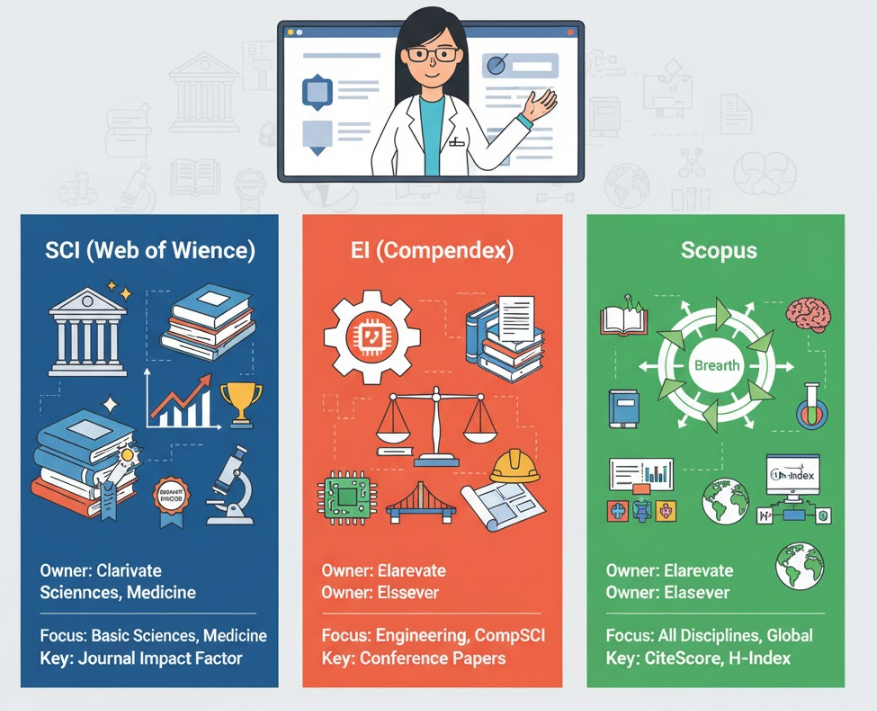

130 views||Release time: Nov 05, 2025
For researchers, academics, and students worldwide, the phrases "publish or perish" and "getting indexed" are central to their careers. The prestige and visibility of one's work are often measured by its inclusion in a major academic database. Among the most respected are SCI, EI, and Scopus.
However, these three databases are not the same. They have different owners, different subject specializations, and different systems for evaluating impact. Understanding their core differences is essential for knowing where to search for literature and where to target your own publications.
Here is a clear breakdown of each.

What It Is: The Science Citation Index (SCI) is a database, now known in its expanded form as the Science Citation Index Expanded (SCIE). It is the most famous and prestigious collection within a larger platform called the Web of Science (WoS) Core Collection.
Owner: Clarivate
Core Focus & Scope:
Subject: Traditionally, SCI is the gold standard for the natural sciences, life sciences, and medicine. Think physics, chemistry, biology, and clinical medicine.
Document Type: SCI is overwhelmingly focused on high-quality, peer-reviewed journals. Its inclusion standards for journals are notoriously strict. It indexes conference papers, but to a much lesser extent than EI.
Selectivity: Its key value proposition is "quality over quantity." It is a curated, selective index of the world's most impactful journals.
Key Metric: The Impact Factor (IF)
SCI is inseparable from the Journal Impact Factor (IF), which is published annually in the Journal Citation Reports (JCR). The IF measures a journal's average number of citations and is a primary tool for ranking and evaluating journal prestige. This is also where the "Quartile" rankings (Q1-Q4) come from.
Bottom Line: SCI (Web of Science) is the authority for basic sciences and medicine, defined by its selective journal indexing and the power of the Impact Factor.
What It Is: Engineering Index (EI) is the oldest and most respected database specifically for engineering. When people say "EI-indexed," they are typically referring to its core database, Compendex.
Owner: Elsevier
Core Focus & Scope:
Subject: As the name suggests, EI is exclusively focused on all fields of engineering. This includes computer science, electrical engineering, mechanical engineering, civil engineering, chemical engineering, and more.
Document Type: This is the most critical difference. Unlike SCI, EI places enormous value on conference proceedings (conference papers), in addition to journals.
Why This Matters: In fast-moving fields like Computer Science (CS) and many engineering disciplines, the most cutting-edge research is published in conferences first, not journals. EI's comprehensive indexing of these conferences (which it calls "CA" for Conference Article) makes it indispensable for engineers.
Key Metric: Compendex Indexing
The main metric for EI is simply being indexed. An "EI paper" (whether a JA - Journal Article or CA - Conference Article) is recognized as a valid, peer-reviewed engineering publication.
Bottom Line: EI is the essential database for engineers and computer scientists, valued for its deep coverage of both journals and critical conference papers.
What It Is: Scopus is the newest of the three and was launched by Elsevier as a direct competitor to Web of Science (SCI). It is the largest abstract and citation database in the world.
Owner: Elsevier (the same as EI)
Core Focus & Scope:
Subject: This is Scopus's biggest strength: breadth. It aims to be a "one-stop shop" for all research. It has excellent coverage of:
Physical Sciences & Engineering (competing with SCI & EI)
Health Sciences (competing with SCI & PubMed)
Social Sciences & Arts and Humanities (an area where WoS is historically weaker)
Document Type: It indexes journals, conference proceedings, books, and trade publications.
Global Reach: Scopus is often praised for having a more international collection of journals, including more non-English publications, than Web of Science.
Key Metrics: CiteScore & h-index
CiteScore: This is Scopus's direct answer to the Impact Factor (IF). It is a journal-level metric calculated similarly.
h-index: While not invented by Scopus, its platform is one of the easiest and most common tools used to calculate an individual researcher's h-index, a measure of both productivity and citation impact.
Bottom Line: Scopus is the largest and most comprehensive database, covering all disciplines (including social sciences) and is excellent for broad literature reviews and analyzing author impact (h-index).
| Feature | SCI (Web of Science) | EI (Compendex) | Scopus |
| Owner | Clarivate | Elsevier | Elsevier |
| Core Focus | Quality, Prestige, Basic Science | Engineering & CS Specialist | Breadth, Scale, All Disciplines |
| Subject Scope | Natural Sciences, Medicine, (Eng) | Engineering & Computer Science only | All Disciplines (incl. Social Sciences, Arts) |
| Key Doc Type | High-Impact Journals | Journals AND Conference Papers | Journals, Conferences, Books |
| Key Metric | Impact Factor (IF), JCR Quartiles | "EI Compendex" Indexing | CiteScore, h-index (Author profile) |
For Basic Scientists (Physics, Chemistry, Biology) & Medical Researchers: SCI (Web of Science) is your most important benchmark. Publishing in high Impact Factor (Q1) journals is the primary goal.
For Engineers & Computer Scientists: EI is essential because it validates your conference publications. Scopus is also highly relevant due to its strong engineering coverage and h-index tracking.
For Social Scientists & Humanities Researchers: Scopus is often your most relevant database, as SCI and EI do not cover these fields comprehensively.